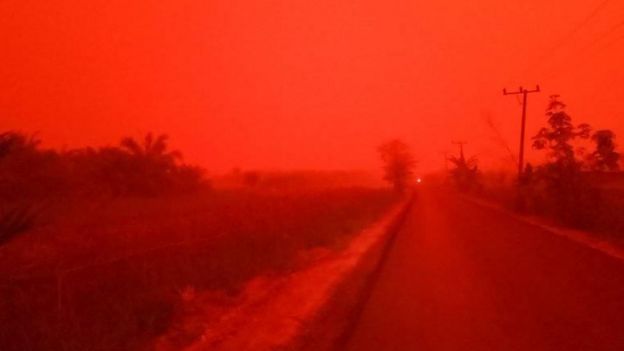 Red is the sky, red is the earth. While smoke from forest fires in Indonesia often simply obscures visibility with a choking haze, parts of Sumatra island recently witnessed blood red skies due to the interaction of sunlight on particles from smoke in the air. A glowing red sky is seen in Kumpeh District in Muaro Jambi Regency, Indonesia in this still image obtained from a September 21, 2019 social media video. The images have been shot by a local student, Muhammad Dani, and they have not been manipulated.
Red is the sky, red is the earth. While smoke from forest fires in Indonesia often simply obscures visibility with a choking haze, parts of Sumatra island recently witnessed blood red skies due to the interaction of sunlight on particles from smoke in the air. A glowing red sky is seen in Kumpeh District in Muaro Jambi Regency, Indonesia in this still image obtained from a September 21, 2019 social media video. The images have been shot by a local student, Muhammad Dani, and they have not been manipulated.INSTAGRAM @DANI_KHOLIK - REUTERS
The Southeast Asian country has spent months battling fires, often caused by slash-and-burn farming practices, as an El Nino weather pattern exacerbates the annual dry season and helps create a haze across the region.
Yunita, a resident who filmed the crimson sky on Saturday, said there had been “strong winds, and the smog was thick. The event lasted from noon until evening, breathing was quite hard on that day”.
The event quickly went viral on social media, with one video notching up over 600,000 views on Instagram in three days.
In order for a red sky to occur aerosols must be present in the air, A. R. Ravishankara, a U.S.-based scientist was cited in an article posted on the website of Scientific American.
Aerosols are solid or liquid particles suspended in air that can originate from both natural processes and human activity. The natural form can come from forest fires, dust kicked up by sandstorms, sea spray or volcanic eruptions, among other things.
Indonesia’s meteorology agency said the sky had turned red in parts of Sumatra due to the “scattering of sunlight by particles floating in the air, also known as Mie scattering”.
The agency said that there had been very thick smoke in the Muaro Jambi area of Sumatra last weekend with satellite analysis revealing many hot spots.
“The smoke from the forest fire was different than other areas experiencing forest fires,” the agency said.
The satellite showed some areas appeared brown but Jambi appeared white, indicating the smoke to be very thick,” the agency said, noting the fires were likely from highly flammable peat.
Yunita, a resident who filmed the crimson sky on Saturday, said there had been “strong winds, and the smog was thick. The event lasted from noon until evening, breathing was quite hard on that day”.
The event quickly went viral on social media, with one video notching up over 600,000 views on Instagram in three days.
In order for a red sky to occur aerosols must be present in the air, A. R. Ravishankara, a U.S.-based scientist was cited in an article posted on the website of Scientific American.
Aerosols are solid or liquid particles suspended in air that can originate from both natural processes and human activity. The natural form can come from forest fires, dust kicked up by sandstorms, sea spray or volcanic eruptions, among other things.
Indonesia’s meteorology agency said the sky had turned red in parts of Sumatra due to the “scattering of sunlight by particles floating in the air, also known as Mie scattering”.
The agency said that there had been very thick smoke in the Muaro Jambi area of Sumatra last weekend with satellite analysis revealing many hot spots.
“The smoke from the forest fire was different than other areas experiencing forest fires,” the agency said.
The satellite showed some areas appeared brown but Jambi appeared white, indicating the smoke to be very thick,” the agency said, noting the fires were likely from highly flammable peat.


